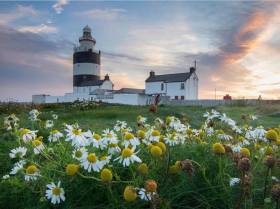Displaying items by tag: Photo Competition Prizes
Launch On May Bank Holiday Festival of 'Great Lighthouse, Great Fun' Photography Competition
#Lighthouses - To kick off summer, Great Lighthouses of Ireland invite you to the 'Shine a Light on Summer' Festival this May Bank Holiday weekend and to take part in a 'Great Lighthouse, Great Fun' photographic competition to capture the best of summer fun at one of their great lighthouses.
To get a glimpse of all the great summer fun you can have at the Great Lighthouses of Ireland, watch this short video.
Shine a Light on Summer Festival
Shine A Light on Summer Festival is taking place from top to toe on the island of Ireland at five of our Great Lighthouses – at Fanad Head in the wilds of Donegal, at Hook the world's oldest working lighthouse in Wexford, at the majestic Loop Head and on the islands of Rathlin in the north and Valentia in the south west.
Be blown away by what you'll see, experience and discover at each site over the weekend. Meet fascinating lighthouse Storykeepers. Enjoy their tales of maritime marvels and nature's wonder, of heroic feats and the lightkeeping life. Discover crafts and traditions of times past and learn about modern coastal technology too.
Find out more by visiting this link.
'Great Lighthouse, Great Fun' Photography Competition
As part of our Shine A Light On Summer Festival, we are launching our 'Great Lighthouse, Great Fun' photography competition.
We invite you to take a photograph that best captures and expresses summer fun at one of our Great Lighthouses of Ireland and enter it into our 'Great Lighthouse, Great Fun' photography competition.
The competition winner will enjoy a fantastic personal Great Lighthouses of Ireland experience for four people, including:
- A two-night stay at any of the Great Lighthouses of Ireland self-catering houses
- A personal tour with our leading 'storykeeper' at any of our lighthouse attractions
- A unique opportunity to meet the Irish Lights historian at Howth's Baily Lighthouse for a chance to see and learn all about the history and heritage of Irish Lights
- A chance to meet the Irish Lights team and learn more about how aids to navigation work today
This fantastic competition opens on Friday 4th May and closes on Wednesday 20th June 2018. To enter, simply post your photo on Instagram, Twitter or Facebook using the hashtag #GreatLighthouseGreatFun.
For full details and the competition terms and conditions, see this link :
Great Lighthouses of Ireland Chairperson, This , will announce the lucky winner during the Seafest www.seafest.ie on Saturday 30th June 2018.
























































